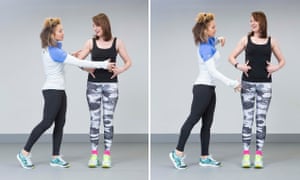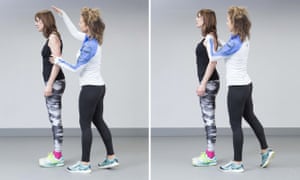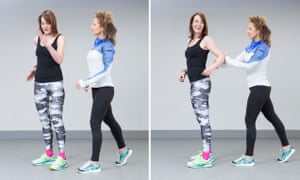Walk yourself fit: how striding out could transform your body
“Some people walk like this.” Joanna Hall, sports scientist, one-time TV fitness guru and now walking expert springs off to demonstrate a walk. She looks purposeful, compact and speedy, like a person on her way to give someone a piece of her mind. It is a fine walk. But I can tell from her manner that it does not meet the criteria of WalkActive, a walking programme Hall devised from scratch eight years ago. “And some people walk like this,” Hall continues. She embarks on a diffident shuffle, with arms swinging aimlessly from side to side.
Although the programme started in earnest in 2010, Hall was cooking it up from the time she had to have an appendix operation, while pregnant, four years before that: a graduate from Loughborough University’s famous sports science degree, pioneer of American corporate weight management programmes, she was suddenly in a wheelchair and steadily gaining weight. “It came from a very personal space to heal myself, improve my posture, safeguard my joints, keep my sanity,” she says. WalkActive grew, at first informally when she integrated it into personal training programmes, and then into a system on its own, for which there is now an app, a book and audio coaching, as well as licensed trainers all over the UK. It is full-time work, changing the way people walk.
Anyway, Hall is still demonstrating: “And some people walk like this,” she concludes, doing a kind of kick out from the knee, like a novice Nazi about to flunk goose-stepping school. All modern scribes of the walk are united on this one thing: it is not supposed to be fast. Walking is, as the philosopher Frédéric Gros described, “the best way to go more slowly than any other method that has ever been found”. If you want to go faster, choose a different transport; maybe skates. The American author Rebecca Solnit wrote in Wanderlust: A History Of Walking: “I like walking because it is slow, and I suspect that the mind, like the feet, works at about three miles an hour. If this is so, then modern life is moving faster than the speed of thought or thoughtfulness.” But Joanna Hall goes fast, at 4.4mph – “beyond that, it starts to look snatched”. One could easily conclude that she has lost the poetry of the walk, but this would be quite wrong. When you start listening to your toes, your ankles, your hips, your chin, you are just making a different kind of poem.
There are four basic errors when it comes to the human walk, and they interrupt everything, from efficiency to posture to joint health. I’ve described them here; be prepared for your walk to end up much faster.
Mistake number one: a passive foot
Start with the basics: your shoes. Trainers are best, with very flexible soles; too rigid and you won’t be able to feel your entire foot. They should have a boxy front rather than one that tapers, so you can feel every toe. Most trainers are a little bit wrong, and Hall is now developing her own. But, she says, by the time you know what you’re doing, you can wear almost anything.
When you slap your foot on the ground like some undifferentiated plate of meat, it negates all your ability to use the muscles at the back of your body, and loads all the work on to your hip flexors. Feet have the same structure as hands – tarsals, metatarsals, phalanges. We should experience the same articulation, the same wriggling and precision, the same fine motor-skilled attention to the detail of the exterior world, but we don’t: it’s more of a slap, slap, slap, or at best, a pad, pad, pad.
You should walk with great attention to your back foot, as though you’re peeling it off the ground like very strong Velcro. You should pay intense heed to the difference between each of your toes, as they touch and leave the ground. You should be aware of your foot’s contours, and this will activate your large posterior muscle chains, the hamstring and the glutes. Along with your active foot will come an open ankle; if you peel your foot off the ground in segments – so it’s not even thinking about becoming airborne until you come to the pivot point between the pad of your foot and your toes – your ankle will open up and become agile, intelligent.
The hamstring, by the way, has two functions, hip extension and knee flexion. One it really enjoys – knee flexion – and the other, not so much. If you stand on one leg and swing the other backwards and forwards, you can see this immediately: your forward swing will be higher than your backward, and on the backswing you’ll want to bend your knee. But when the hamstring is properly “recruited” – this is what it’s called, when a movement activates a muscle – it has huge propulsive power, as well as opening up the world in which your glutes (butt muscles) can also do some of the work.
All of this is moot until you’ve started using an active foot; before that, hip flexors just dominate, accruing all the power and then not knowing what to do with it. It all sounds pretty straightforward but also, impossible: how can it be that simple, that one minute you start thinking of your back foot as Velcro, and the next, you have activated the right muscles, in the right way, in the right sequence?
At this point, you have to suspend your disbelief and try it. The concentration it requires beggars belief. Hall says at one point, “it’s like patting your head and rubbing your tummy – it takes a lot of brain power”. I didn’t believe her for one second, but of course it was true. Even chatting at the same time as having an active foot was a challenge. Having an active foot and a hip lift was like trying to do a sudoku while listening to Motörhead.
Mistake number two: failing to hip lift
Part of my walk tutorial is in the original YMCA building in central London – a cavernous gym with incongruous snatches of stained glass reminding exercisers of a higher religious purpose. Every time someone walks past, Hall waspishly critiques their walk (eg: “Look at the bend in his knees and his arms are swinging like hinges”). This becomes more and more enjoyable as her meaning unfolds.
A lot of people, thinking themselves on a “power walk”, brace themselves, particularly their abs. But you don’t really want to be braced, you want to be taut. Bracing your abs and glutes makes you feel as if you’re making an effort, but it silos your muscle groups. Tautness, on the other hand, lengthens and connects them, activating the connective tissue (the fascia) that holds the show together.
Becoming taut is all in the hip lift. “You should imagine you’re putting on a very expensive pair of tights,” Hall said, “inching up each leg very carefully, ending at the hips.” I’m actually learning quite a bit about how to put on tights, but still baffled about hip lifts. “May I touch you?” she says. Sure, I say. She physically lifts my hips up, away from my legs. Once I know what it should feel like, I can do it myself, but only if I think extremely hard.
The effect of this is even more striking than that of the active foot: the abdominal muscles seem to kick in on their own, and the collar bones drop and straighten in a queenly, warrior fashion. My walk becomes a lot more regal, yet paradoxically, faster. “May I touch you?” Hall asks again, because I can only keep this up for maybe 20 paces before I forget and sink back into my hips.
“You can just take this as blanket permission to touch me whenever you like,” I consider saying. It sounds a bit rude. I toy with some other formulations – “sure, mi casa es su casa” – and in the throes of that mental effort, my walk disintegrates entirely. Not only can I not do the new walk, I’ve forgotten how to do my old walk. When you first start to follow this technique, Hall’s advice is to do three 10-minute walks every day; any longer than that, and you won’t be able to concentrate.
Mistake number three: jutting out your neck
You ought to walk as if you’re wearing very long diamond earrings, and you want everybody to be able to see the diamonds, rather than having them sitting on your collar bones. When your head is forward, your shoulder girdle also rolls forward, which gives you an unappealing hunch, but more importantly, encourages the shoulder joint, which is a ball-and-socket joint, to behave like a hinge joint. This makes your arms as good as useless in the business of moving you forward, but also stiffens the shoulders, which makes the spine rigid. The spine should be able to rotate. I don’t know why, but I accept as a general principle that if your skeleton is capable of a range of movements that you never do, that’s a bad thing.
Mistake number four: ignoring your arms
With everything else in place – your hips lifted, your neck long and straight – the ball-and-socket joint of the shoulder should be liberated and your arms should shuffle themselves quite freely and intuitively into the right movement pattern. Except that it’s not quite that simple: if you want to use them as agents of acceleration, and you do, you have to use more deliberation. Move your arms across to the centre of your body and then quite far back.
To reach your optimum pace, the one at which you burn the most calories, you need to establish your break point, the moment that you’re going so fast that your walk deliquesces and you have to break into a jog. Then drop down to about 5-10% below that, and you’re at your personal walking peak.
There are three phases to speeding up: start to use your toes in a more determined way, as if you’re kicking off the back wall of a swimming pool; then concentrate on your hip lift and hark, your glutes will propel you forward; finally, start to swing your arms, concentrating on the elbows – speeding up your arms will naturally make your walk faster.
“This has all been scientifically proven,” says Hall. “Dr Darren James, research fellow at South Bank University, has done a study showing all this. WalkActive significantly and statistically improves your posture, increases your walking speed by up to 24%, reduces joint impact, joint stress at the knee and at the ankle and improves your body shape.” It is, unmistakably, a fitness programme, as in, you would undertake it for the same reasons as an aerobics class, to lose weight, or at the very least, redistribute it in a more sightly way. I did several 10-minute walks, and while never out of breath, was certainly more tired at the end than I would normally have been.
But once you could do it instinctively, I can’t imagine why you’d go back to your regular walk. This is not a fitness walk; this is an everyday walk that happens to make you fit. As Hall lists the evidence in its favour, with the zeal of a person who loves to solve problems, WalkActive sounds further and further away from the amble, the mosey, the saunter.
The canon of walking literature has centred, almost entirely, on the infinite charms of an activity that nobody has ever tried to be good at. But the human body has charms of its own, and when its movements go from wrong to right, you recognise it like a melody. Maybe it’s possible to be dynamic and contemplative. Either way, there’s no looking back.
Where to start: Joanna Hall’s open ankle drill

1: Stand on a level piece of ground with your feet together. Take a large step back with one foot, placing the whole of the foot on the ground. You should feel a stretch on the calf of your back foot. Having your feet hip distance apart will help with balance. If you don’t feel a stretch, increase the distance between your front and back foot.
2: Keeping the feet where they are, come to a ballet point position with your back foot. You should be right up on to the tip of your big toe of the back foot. Feel how your leg is long; there is an opening of your ankle and you may also feel a stretch down the front of your thigh and hip. You may need to use a chair to help you with balance.
3: Ease your heel back down towards the ground, but keep the heel pad off the floor. There should be just enough of a gap for someone to be able to slide their hands between the ground and your heel pad. This is your closed ankle position – notice how your weight is back and you are sitting more in your hips.
4: Now to find your true open ankle position. Slowly peel through the back foot until you come to the pivot point between the pad of your foot and your toes. Take a moment to check this position as it will change as your feet become more mobile, strong and fit. Once you have this pivot position hold it there. It’s this position you are trying to achieve with each step as you walk.
Technique one: your hips

Aim: to stop slumping and to achieve hip stability without rigidity.
Payoff: improve your knee and hip alignment, reduce the impact on your joints; you’ll start to tighten your lower abdominal muscles, trimming your torso; your bottom will start to lift, tighten and work properly. Try this:
1. Put your hand on your tummy and draw the stomach upwards and inwards but don’t tense it completely. Your bottom should be completely relaxed and the torso long.
2. As you walk, imagine you have a glass of water balanced on each hip. Visualise these as being lifted and balanced as you walk.
Technique two: head and shoulders

Aim: to achieve symmetry through the torso.
Payoff: combats poor posture, especially slumped shoulders and a rounded back (above left); reduces tension in the upper back and helps mobility; achieves length and softness without looking stiff and tense. You can apply this technique generally in your day-to-day life, not just when you are walking but when you’re standing and sitting, too.
Try this:
1. Simply imagine lengthening the space between the earlobes and shoulder and relax the shoulders down.
2. Look up and forward and don’t tense the neck.
Technique three: your arms

Aim: to get the arms to move like flowing pendulums as you walk.
Payoff: Your back, neck and shoulders will start to become more agile; you’ll enjoy better shape and tone in your chest and arms.
Try this:
1. Have a small bend at the elbow and use a fluid arm movement backwards and forwards, pushing much further backward than forward. Posturally, this opens up the shoulders, and increases mobility in the upper back.
2. Don’t clench your fists tightly, as this limits correct shoulder positioning. Do not use the mechanical ‘power walking’ arm movement (above, left). Try to lead with your elbow on the back swing (above, right)
For more information, go to walkactive.com
• Commenting on this piece? If you would like your comment to be considered for inclusion on Weekend magazine’s letters page in print, please email [email protected], including your name and address (not for publication).
Source: Read Full Article
